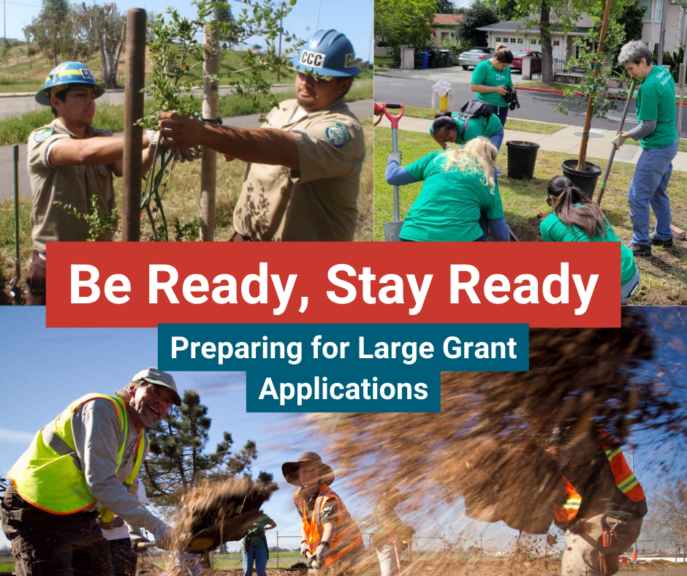
Are you ready? An unprecedented amount of public funding for urban and community forestry grants will be available over the next few years at the state and federal levels.
At the Partners in Community Forestry conference in Seattle, the week before Thanksgiving, Beattra Wilson, Director of Urban & Community Forestry with the US Forest Service, challenged everyone to be ready and stay ready for the $1.5 billion in funding for urban and community forestry competitive grants provided by the Inflation Reduction Act (IRA). The funding was approved for 10 years, however, it will take the USFS U&CF program department some time to establish the grant programs. Beattra indicated that there would likely be about 8.5 years for the grant action & implementation by grant awardees.
Additionally, significant funding opportunities in California are expected, including the new Green Schoolyard Grant program (guidelines now open for comment) and other traditional grant programs like Urban Forest Expansion & Improvement. And the timelines will be also be rather short to develop and submit grant applications.
So how can your organization “be ready” and “stay ready” for these grant opportunities? Here is a list of ideas to consider in planning and preparing your “shovel-ready” grant program applications, as well as capacity building.
Ways You Can Be Ready & Stay Ready for Large Grant Funding Opportunities:
1. Stay up-to-date with CAL FIRE’s Urban and Community Forestry Grant Programs – Visit their page to read and provide public comment for the 2022/2023 Green Schoolyard Grant Guidelines (by December 30th) and find other helpful resources.
2. Prepare and inform your Board about upcoming grant funding to ensure they can move quickly to approve grant applications.
3. Expect a continued focus on planting in neighborhoods that lack tree canopy as part of California’s ongoing emphasis on environmental justice as well as the federal Justice40 Initiative.
4. Create a working list of several potential locations for urban forest planting, tree care, or other related activities such as outdoor classrooms, community orchards, and tree protection (active preserving & caring for existing urban trees). Begin to initiate conversations with the landowners about potential grant funding.
5. Familiarize yourself with online environmental screening tools and get to know the equity, health, and adaptability scores of the neighborhoods you want to plant in by using tools like CalEnviroScreen, Tree Equity Score, Cal-Adapt, and the Climate and Economic Justice Screening Tool.
6. Develop a basic grant program outline you would like to implement in your town that can be quickly adapted to fit the design parameters of upcoming urban forest grants.
7. Work on developing realistic and modular draft budgets, which can be scaled up or down and updated with new features to meet new grant requirements.
8. Consider revising and “readying” a previous unfunded grant application for another funding opportunity.
9. The survival of our trees has become more critical than ever with the drought and extreme heat issues in California. What serious, long-term plans is your organization making to ensure the trees are watered not only for the first three years but forever? How will you communicate your commitment and tree care plan in your grant application?
Capacity Building
1. Consider your staffing needs and how you can quickly ramp up staffing if you are awarded a large grant. Do you have partnerships with other local community-based organizations that could be subcontractors for outreach? Do you have senior staff or experienced advisors ready to answer questions and provide personal support?
2. Are you using spreadsheets for employee payroll, time tracking, and benefits, or have you moved to an online tracking system like Gusto or ADP? Spreadsheets work when you’re small, but if you plan to grow quickly, an automated system should be considered to help you easily generate payroll reports for grant invoice backup.
3. Think about ways you can expand and strengthen your volunteer base. Do you have an existing training program that can quickly onboard new volunteers and strengthen the capacity of existing volunteers? If not, who can you partner with?
4. Do you have savings/funding reserves, or is it time to research getting a revolving Line of Credit so that you can handle the larger grant expenses and potential delays in reimbursement?
5. Consider how you can scale up tree watering and maintenance. Is it time to invest in a watering truck or hire a watering service? Can the cost be built into your budget and/or your other fundraising actions?
